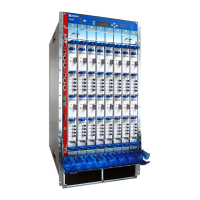3. Plug the female end of the RS-232 serial connector into the CONSOLE port or AUX
port on the Connector Interface Panel (CIP).
4. Plug the other end of the cable into the management device.
5. Tighten the screws on the connector.
Connecting to a Network for Out-of-Band Management
NOTE: Before you can use the Ethernet management port to connect to a
network for out-of-band management, you must perform the initial Junos
OS configuration after the router has been powered on. See “Step 8:
Performing the Initial Software Configuration” on page 42
1. Locate the appropriate cable and connector.
2. Plug one end of the Ethernet cable into the ETHERNET port on the CIP.
3. Plug the other end into the networking device.
Connecting the PIC Cables
WARNING: Do not look directly into the fiber-optic transceivers or into the
ends of fiber-optic cables. Fiber-optic transceivers contain laser light sources
that can damage your eyes.
CAUTION: To prevent damage to fiber-optic transceivers and fiber-optic
cables, observe the following precautions:
•
Do not leave a fiber-optic transceiver uncovered except when inserting or
removing cable. The safety cap keeps the port clean and prevents
accidental exposure to laser light.
•
Do not bend fiber-optic cable beyond its maximum bend radius. An arc
smaller than a few inches in diameter can damage the cable and cause
problems that are difficult to diagnose.
•
Do not let fiber-optic cable hang free from the connector. Do not allow
fastened loops of cable to dangle which stresses the cable at the fastening
point.
1. Identify the appropriate cable to be connected to each PIC.
2. Insert the appropriate cable connector into the PIC cable receptacle.
3. Drape the cable over the bobbins of the cable management system to protect them
from bending past their recommended bend radius.
21Copyright © 2015, Juniper Networks, Inc.
Connecting to a Network for Out-of-Band Management

